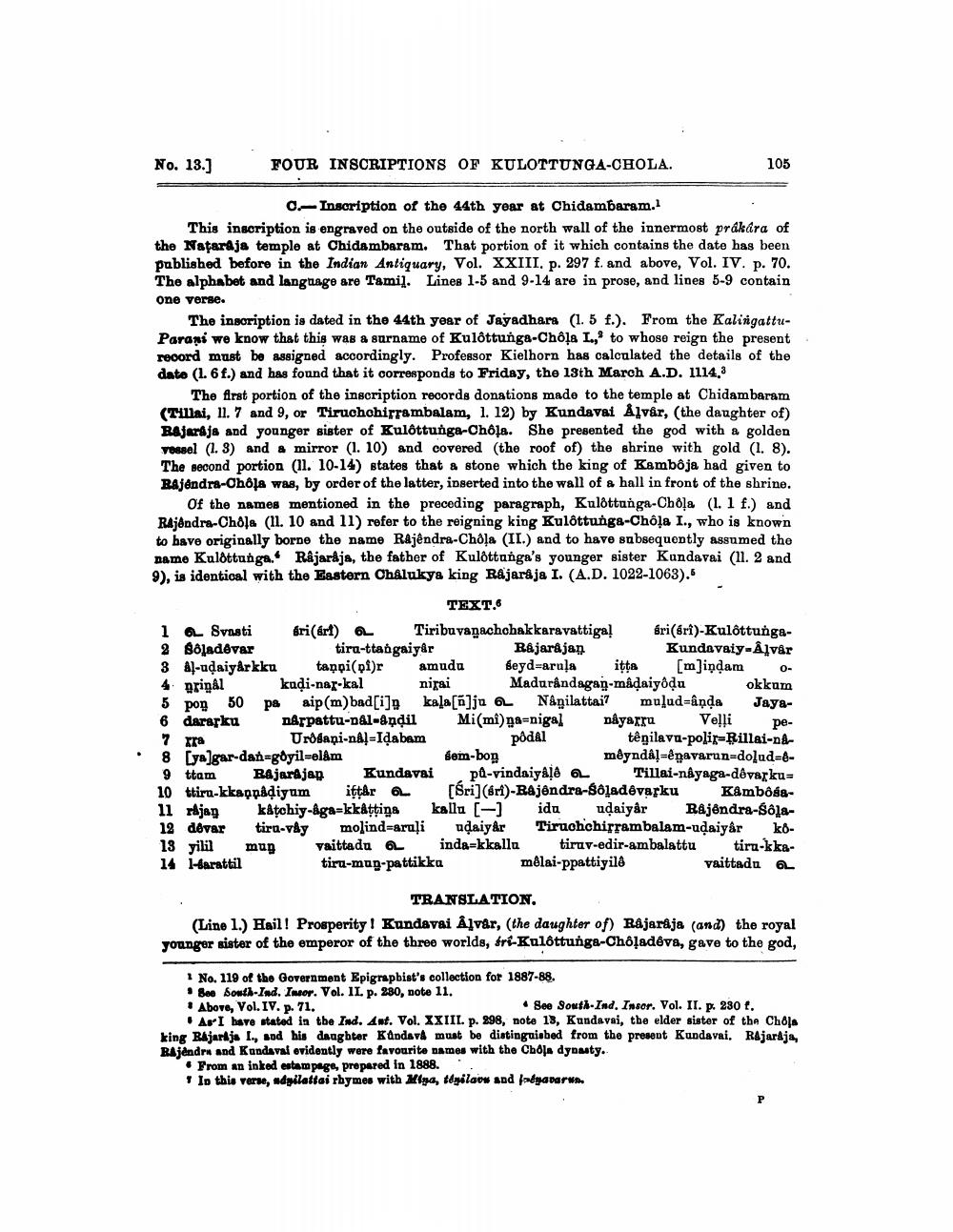________________
.
No. 13.]
FOUR INSCRIPTIONS OF KULOTTUNGA-CHOLA.
C.-Inscription of the 44th year at Chidambaram.1
This inscription is engraved on the outside of the north wall of the innermost prákára of the Nataraja temple at Chidambaram. That portion of it which contains the date has been published before in the Indian Antiquary, Vol. XXIII. p. 297 f. and above, Vol. IV. p. 70. The alphabet and language are Tamil. Lines 1-5 and 9-14 are in prose, and lines 5-9 contain
one verse.
The inscription is dated in the 44th year of Jayadhara (1. 5 f.). From the KalingattuParani we know that this was a surname of Kulôttunga-Chôla L., to whose reign the present record must be assigned accordingly. Professor Kielhorn has calculated the details of the date (1.6 f.) and has found that it corresponds to Friday, the 13th March A.D. 1114,3
The first portion of the inscription records donations made to the temple at Chidambaram (Tillai, 11. 7 and 9, or Tiruchchirrambalam, 1. 12) by Kundavai Alvar, (the daughter of) Bajaraja and younger sister of Kulôttunga-Chôla. She presented the god with a golden vessel (1.3) and a mirror (1. 10) and covered (the roof of) the shrine with gold (1. 8). The second portion (11. 10-14) states that a stone which the king of Kamboja had given to Rajendra-Chôļa was, by order of the latter, inserted into the wall of a hall in front of the shrine.
Of the names mentioned in the preceding paragraph, Kulôttunga-Chola (1. 1 f.) and Rajendra-Chôla (11. 10 and 11) refer to the reigning king Kulôttungs-Chôla I., who is known to have originally borne the name Rajendra-Chôla (II.) and to have subsequently assumed the name Kulôttunga. Rajaraja, the father of Kulôttunga's younger sister Kundavai (11. 2 and 9), is identical with the Eastern Chalukya king Rajaraja I. (A.D. 1022-1063).
TEXT.6
105
16 Svasti éri (ért) 6 2 Bôjadevar
tira-ttangaiyar 3 Al-uḍaiyarkku tappi(pi)r 4 prinâl kuḍi-nar-kal
5 pon 50 pa aip (m) bad[i]n 6 dararku narpattu-nål-âṇḍil Urosapi-nal-Iḍabam
Tiribuvanachchakkaravattiga! éri(sri)-KulôttungaRajarajan Kundavaiy-Alvår amudu Seyd=arula iṭṭa [m]inḍam 0nigai Madurândagan-mâḍaiyôḍu okkum kala[n]ju o Nanilattai mulud=âṇḍa JayaMi(ml)ga-nigal mayazru Velli pôdal têgilava-polir-Billai-namêyndal-ênavarun-dolud=êTillai-nayaga-dêvarku=
pe
pa-vindaiyal
7 rra
8 [yalgar-dan-gby-elm
9 ttam Rajarajan Kundavai 10 ttira-kkappadiyum iṭṭar 6 11 rájan katchiy-aga-kkaṭṭina 12 dévar tiru-vây molind=aruli 13 yilil mug vaittadu
14 1-4arattil
tiru-mug-pattikka
sem-bon
[śri] (éri)-Rajendra-Śôladêvarku Kâmbôsakallu [-] idu uḍaiyâr Rajendra-Solauḍaiyar Tiruchchirrambalam-uḍaiyâr köinda-kkallu tiruv-edir-ambalattu tiru-kkavaittadua
mêlai-ppattiyilê
TRANSLATION.
(Line 1.) Hail! Prosperity! Kundavai Âlvår, (the daughter of) Râjarâja (and) the royal younger sister of the emperor of the three worlds, fri-Kulôttunga-Chôladêva, gave to the god,
1 No. 119 of the Government Epigraphist's collection for 1887-88.
See South-Ind. Insor. Vol. II. p. 230, note 11.
Above, Vol. IV. p. 71.
See South-Ind. Insor. Vol. II. p. 230 f.
As I have stated in the Ind. Ant. Vol. XXIII. p. 298, note 13, Kundavai, the elder sister of the Chola king Bajaraja I., and his daughter Kandavá must be distinguished from the present Kundavai. Rajaraja, Rajendra and Kundaval evidently were favourite names with the Chola dynasty.
From an inked estampage, prepared in 1888.
In this verse, adgilattai rhymes with Mina, ténilavu and Jégvarun.
P




